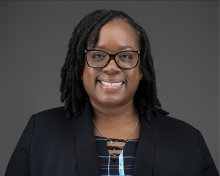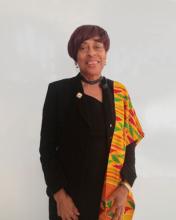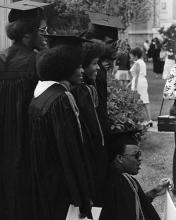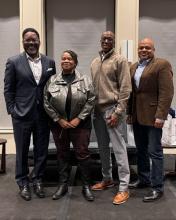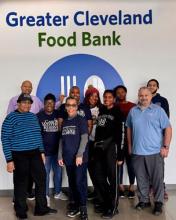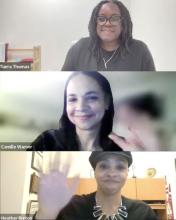President’s message
Dear African American Alumni Association,
Happy 2024! I hope you're having a fantastic start to the year and that Black History Month was both enriching and meaningful for you.
Did you know that, since 1976, every U.S. president has endorsed a specific theme for Black History Month? This year’s theme was “African Americans and the Arts,” exploring our influence across various cultural expressions. It's a celebration of our impact on literature, fashion, music, and more, shaping the world around us.
I'm immensely grateful for everyone who participated in events hosted by the Case Western Reserve University Office for Diversity, Equity and Inclusive Engagement, from the screening of A Trumpet at the Walls of Jericho to the Profiles of Inclusive Excellence Speaker Series. Your presence and engagement made a significant difference.
If you missed out on these events, don’t worry! There are plenty of opportunities ahead. As we move forward, my goal is to engage even more African American alumni in our activities and initiatives. Here's how you can stay involved:
- Complete the forms at the bottom of this newsletter so we can connect you to one of our committees or other opportunities.
- Follow us on Facebook!
- Join the African American Alumni Association digital yearbook on BrightCrowd to be part of our legacy (details later in the newsletter).
- Support the Reach Beyond Legacy Campaign on CWRU’s Day of Giving, April 10.
- Attend African American Alumni Association events and contact us alumnirelations@case.edu to suggest others.
Speaking of events, please see below for upcoming programming and mark your calendars for Case Western Reserve University's 2024 Homecoming and Reunion Weekend, which will be November 14–17. We hope to see you then!
Enjoy this newsletter and its celebration of Black excellence in the CWRU community!
Warmest regards,
Tiarra Thomas (CWR ’12)
'Back in the Day'
Each issue, "Back in the Day" will share the perspectives and experiences of African American alumni of Case Western Reserve in their own words. This issue's column was written by Barbara A. Simmons (WRC '73, SAS '77).
Did you know there was an all-Black dorm at CWRU during the 1972-73 school year?
In 1969 when my class arrived on campus, Black students were automatically given white roommates. Many of us changed when we could. It was not that I had any problems with my white roommate, it was just that I wanted a “Sistah.”
This was a time in the country when many Black folks were not ashamed to be proud of who they were. They didn’t feel the need to be apologetic for loving themselves and their kind, and unlike today, it was unthought of to call Blacks with a love for Black people “racist.” Some may have seen it as a rejection of whites when, instead, it was an affirmation of self. Perhaps, some of the problems in our community today derive from a lack of self-affirmation.
By my senior year, Black students requested and were granted an all-Black dorm. Many had experienced the frustration and exhaustion of trying to be validated in what at times was a hostile environment. Sherman House became the dorm, and Stephanie Tubbs, later the Honorable Stephanie Tubbs Jones, was named House Mother. True to who she was, Jones served as the strong, evenhanded, problem-solving nurturer and leader of the House. I was assistant House Mother.
Back in the day, rooms were called to announce visitors. One favorite memory of living in the dorm was the day someone had a visitor, and the switchboard operator called her room and put her on the loudspeaker. When she asked, "Who is it?" the operator let the guy get on the mic, and he started singing, "If you don't know me by now, you will never, never, ever know me." We all fell out laughing.
Living in the Black dorm was a wonderful experience for me. It was a caring, supportive family-like environment. To my knowledge, there has never been another Black dorm after our graduation in 1973.
'Did You Know?' Black history exhibit at CWRU
If you’re in Cleveland, why not plan to spend some time in Kelvin Smith Library at the absorbing exhibit “Did You Know? Black History at CWRU” created by Edwin Mayes, director of First Year Experience, and the Black History Committee, which includes I’Maya Gibbs, an undergraduate history major; Elizabeth Meinke, exhibitions librarian; Janice Eatman-Williams, director of school-based outreach; and Janice Gerda, associate vice president of student engagement and learning.
You will discover that Case Western Reserve University has historically championed Black civil rights and positioned itself at the epicenter of Black freedom struggles. Founded in 1826, Western Reserve College was located in Hudson, Ohio—a town active in the Underground Railroad. In 1836, John Sykes Fayette became the first Black graduate of the college, which assumed the name Western Reserve University in 1882 when it moved to Cleveland. It would later become Case Western Reserve University, after the federation of Western Reserve and Case Institute of Technology in 1967.
In the early 20th century, most institutions of higher learning did not record the race of students, so it was difficult to capture precise Black enrollment. However, a letter in 1933 written by Western Reserve University’s eighth president, Robert Vinson, reported that 65 of the 7,507 students were identified as “Negro,” and WRU encouraged “able Negroes" to attend.
This is not to imply that implicit barriers and exclusionary admission policies were nonexistent. Until later in the 20th century, the lack of a documented policy concerning admittance based on race allowed specific programs to deny acceptance to Black students. For example, neither the Frances Payne Bolton School of Nursing, when added in 1923, nor the School of Architecture, when added in 1929, would admit people of color.
Still, CWRU’s legacy is embedded within Black scholarship and excellence, having produced such trailblazers as Clemence Greene, who in 1915 became the first Black pharmacology graduate from WRU; and 1929 graduate Florence Bundy Fairfax, for whom the Cleveland Fairfax neighborhood is named.
Many prominent Black leaders are CWRU alumni, including Louis Stokes, the first African American Congressman elected in Ohio; Stephanie Tubbs Jones, the first African American woman from Ohio to be elected to Congress; Robert P. Madison, the first African American architecture graduate in Ohio; and Fred D. Gray, the renowned civil rights attorney, are all CWRU alumni.
The exhibit includes information on CWRU’s Black clubs and organizations, monuments to Black history, most-recently recognized recent trailblazers, and more. It will be at Kelvin Smith Library through the end of March.
Celebrating Black LGBTQ+ narratives
In February, the African American Alumni Association and the LGBTQ+ Pride Affinities presented the engaging panel discussion “Intersections: Celebrating Black LGBTQ+ Narratives.” It was moderated by Bryan Adamson, JD (LAW ’90), associate dean of diversity at CWRU School of Law, and panelists included Phyllis “Seven” Harris (MNO '05), executive director of the LGBT Community Center of Greater Cleveland; Lance Jethrow (CWR '01), a transportation engineer with the Ohio Department of Transportation; and Larry G. Webb (LAW '95), district director in the Washington Metropolitan District Office of the U.S. Small Business Administration.
Harris, who came out to a vibrant women’s community in Cleveland Heights when she was 19, appreciated the fact that the “funny” people in her family, as they were called then, were cherished and loved. A Black gay couple for whom she babysat was her model of what gay could be.
Webb recognized that being queer was undesirable, though he was comfortable with who he was. Although things didn’t go well when he came out to his mother, “I knew that I was right and they were wrong,” Webb said.
Jethrow grew up in the church, denying who he was and hoping to meet the perfect woman who would make him “not gay.” College friends encouraged him to accept and love himself.
Jethrow and the other panelists expressed feeling “more Black than gay” on campus. They identified with the pressing issues confronting Black people in America and found community with other Black students.
Different occupations seem to have different nuances to the challenges of being LGBTQ+ and Black.
As an engineer working with mostly straight white men, Jethrow felt a responsibility to do a good job and “represent the Black race well,” keeping his sexual identity in the background. While Harris was more free to be her authentic self at the nonprofits she has worked for, she acknowledged the difficulty of being a Black lesbian feminist in leadership and dealing with the interconnectedness of all the “isms.”
The cost of being out for Black people can include isolation and loss—loss of networks and connections, loss of the potential of what their lives could have been. The panelists have mourned their losses and moved on, seeing their intersectionality as a gift.
Harris is in a place of gratitude. Webb is proud of his work with youth and the community he built in Cleveland. Jethrow leverages his identities to help others without access. They encouraged us to talk to others different from ourselves and “find the threads of humanity among us all.”
Addressing food insecurity on campus
When members and friends of the African American Alumni Association gathered for their sixth annual service project at the Greater Cleveland Food Bank in February, they had no idea that some of those benefiting from distributions would be CWRU students.
Case Western Reserve’s Physical Resource Center formalized a partnership with the food bank last month, aiming to address the growing issue of food insecurity on campus and extend support to the wider community.
The center will now receive monthly deliveries from the food bank with items such as frozen meals, chicken, rice, pasta, soups, milk, shredded cheese and more. The center will also maintain a stock of fresh produce and continue to host the food bank’s mobile food pantries each semester. Read the full story in The Daily.
Profiles of Inclusive Excellence
On Feb. 21, Tiarra Thomas (CWR '12) introduced Heather Burton, PhD, during Profiles of Inclusive Excellence, where she engaged in a one-on-one interview with Camille Warner, PhD. Burton highlighted Warner's extensive expertise in sociology, aging, medical sociology and intergenerational caregiving, alongside her dedication to advancing diversity, equity and inclusion in higher education and healthcare.
Head to Profiles of Inclusive Excellence page to watch previous recordings and sign up for our upcoming speakers at the end of March and in April.
BrightCrowd
This innovative digital platform provides personalized pages for connecting with other alumni and sharing life updates, cherished memories, accomplishments and photos. Your page is a place to showcase your achievements and capture your impact for future generations. Be a part of our legacy by joining:
- Sign up with your preferred email address for access.
- Enter the case-sensitive access code: cwruaaaa.
- Follow the instructions in the email from BrightCrowd to verify your email address.
- Once you agree to the terms, you can begin creating your page!
Black business
We would love to promote your business in the newsletter and/or include it in the AAAA Directory of Black Businesses. Please send your name, affiliation, business name and focus, and business email, website, and/or phone number to alumnirelations@case.edu
Stay connected
What would you like to see highlighted in future newsletters? Have news to share? Know someone who wants to receive AAAA communications? Update your information using Affinity Communications Opt In Form.
Want to become a member? Enter your information in the CWRU African American Alumni Registry.
Remember to follow our Facebook page.


